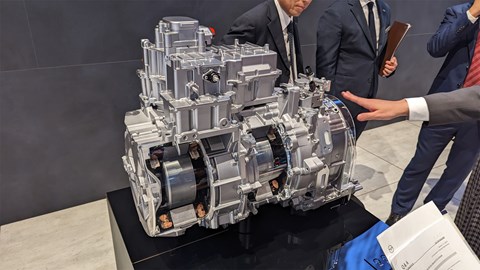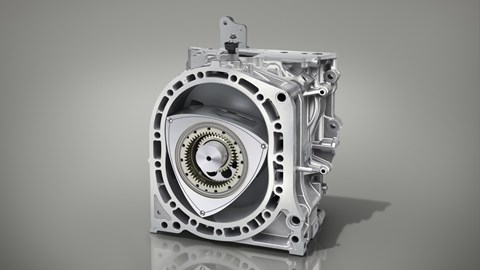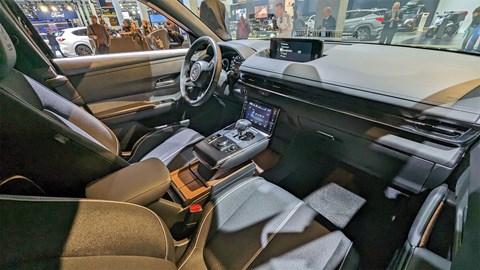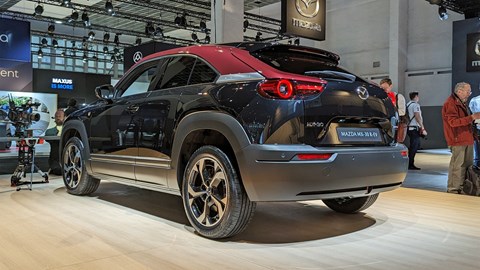► Wankel-equipped version of Mazda’s MX-30 EV
► 53 miles of EV range plus a 50-litre petrol tank
► Priced identically to electric model
After years of promising us that the rotary engine isn’t dead, Mazda’s finally put its money where its mouth is and delivered. The new Mazda MX-30 R-EV plug-in hybrid may not be a spiritual successor to legendary cars such as the Mazda RX-7, but it does represent two important things for the brand – a long-range electric car, and the revival of an engine technology that’s intricately woven into its history.
The new MX-30 R-EV makes its debut at the Brussels motor show. It’s unsurprisingly based on the same base vehicle as the MX-30 EV, launched in 2020, but its rotary engine tech could represent a significantly more useful product, given its pure electric sibling only has a hundred or so miles of real-world range.
This MX-30 range extender will launch in the UK later in 2023.
What’s under the skin of the Mazda MX-30 R-EV?
The R-EV utilises a newly-developed 830cc single-rotor petrol engine. Extremely compact and light, it shares the engine bay with a generator and a 125kW/168bhp electric motor which ultimately powers the car.

With no mechanical connection between the engine and the wheels, it acts purely as a generator creating a series hybrid system similar to Nissan’s e-Power arrangement. Unlike the Nissan system, however, the R-EV is set up as a plug-in hybrid, with the 17.8kWh battery back capable of delivering around 53 miles of pure electric range. 1500W of vehicle-to-load functionality is also included.
Fire up the engine and the MX-30 R-EV’s 50-litre tank can add a claimed 320 miles to this figure, bringing the car’s total range to 373 miles. The small-capacity battery means that a 20-80% charge takes just 25 minutes, though the max charge rate of just 36kW is a little stingy.
Tell me more about that Wankel…
Mazda has more experience than anybody else with the rotary engine, but even its last model – the Mazda RX-8, discontinued in 2012 – suffered the same reliability issues and high running costs as its predecessors. The brand hopes that by wresting control of the engine away from the driver and operating it solely in a generator capacity that these issues won’t surface.
The engine itself is an 830cc single-rotor unit, with a 120mm rotor radius and 76mm rotor width. It’s larger in capacity than the 13B engine used in the RX-8 but smaller and significantly lighter, with aluminium used for a large part of the engine structure.

Engine efficiency is improved by the use of direct fuel injection, reducing the tendency for the fuel/air mixture to collect at the back of the combustion chamber and not fully combust. There’s also an exhaust gas recirculation system, operating mostly at low rpm to prevent cooling loss – a struggle in a rotary which has a greater surface area than a piston engine of equivalent capacity.
Rotor tip wear – a bugbear of past Wankels – will hopefully be mitigated by the use of wider, 2.5mm seals. There’s also new plating on the curved walls inside the housing.
The engine’s total output is 73bhp at 4,700rpm.
What’s it like to drive?
We’ll report back on this when we’ve actually driven the MX-30 R-EV, but the fact that the rotary never directly powers the wheels means the driving experience should be very similar to the pure electric MX-30.

Drivers can choose from Normal mode, EV mode and ‘Charge’ mode for driving, but top speed is 87mph regardless. We’re very interested to see how the rotary generator affects refinement – the distinctive engine note will presumably be damped as much as is possible.
How much does the Mazda MX-30 R-EV cost?
Bafflingly, Mazda’s priced the R-EV identically to the regular MX-30 EV. Both start from £31,250 on the road.
That does therefore beg the question why anybody would opt for the EV with its circa-100 mile real-world range when for the same price they can have the flexibility of a petrol range extender.

Running costs for the R-EV will be interesting to find out. Of course being a plug-in hybrid means the WLTP figure of 282mpg is little help here, though the official CO2 figure of 21g/km is usefully low. Reading between the lines, the range extender’s 50-litre fuel tank and 320 miles of added range averages out to below 30mpg, which is somewhat less than impressive – we’ll report back on this once we’ve driven the MX-30 R-EV ourselves.
Anything else I need to know?
Trim levels will largely mirror the MX-30 EV but include a special ‘Edition R’ car which ‘commemorates the return of the rotary engine’. There’s a new signature colour – Maroon Rouge Metallic, which looks to us like Soul Red Crystal after a rough night but Mazda says pays homage to the roof colour of its R360 coupe.
Edition R cars get a unique keyfob designed to mirror the curves of the engine’s rotors, exclusive floor mats with orange tags and chrome-plated badges, and embroidered headrests. It’ll top the trim levels at £37,950.
When can I buy one?
UK cars will arrive at dealers in Summer 2023. We’ll be driving the MX-30 R-EV ahead of this, so check back for our full review when we do.